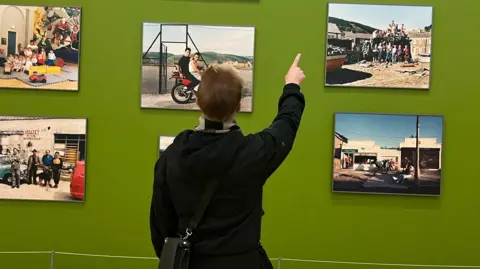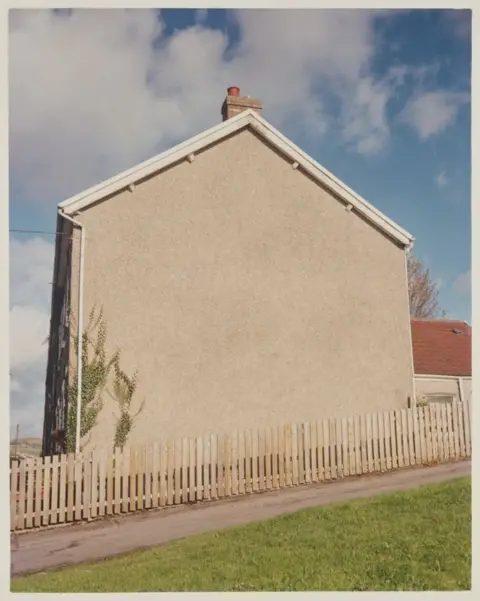Star's enduring love for his valleys roots
 Tom Hope PR
Tom Hope PR"My friends are still in the valleys, my family are still in the valleys, my heart is in the valleys."
Ian Watkins, better known as H from Steps, has an almost three decades-long pop career as well as more recent success as a painter, but he has never forgotten where he came from.
The star was brought up in Cwmparc in Rhondda in south Wales, and has fond memories of nearby visits to his paternal grandmother in Ton Pentre and maternal grandfather in Treherbert.
He said the artworks on show at a special exhibition depicting the south Wales valleys felt like seeing "my life flashing before me".
"All the stories I've had from my grandparents and my parents and also the life I've lived - it is kind of incredible to see it all in one place," he said.
The Valleys exhibition, on show at National Museum Cardiff, has brought together a collection of more than 200 pieces of art, including paintings, photography, film and applied art, depicting life in the valleys.
The exhibition explores how the area was transformed by the explosion of industry and its subsequent decline.
 Tom Hope PR
Tom Hope PRThe singer said he recognised many of the landscapes in photographs or paintings as he had painted them himself.
The depictions of men, both at work and play, made him think of his grandfather.
"He was a miner - I've actually got his miner's lamp in my house," he said.
"He used to tell me amazing stories: he was one of 13 children and they used to top and tail in beds, their mother would make all of their sandwiches in tin boxes to go down the mines, they'd give her part of their pay packet, they'd all get scrubbed in a tin bath in the front room and they had constant 'eyeliner' on because of the coal dust.
"People made do with what they had and made the best of it."
From the stunning green landscapes to the black soot of industry, Watkins said he was happy to see the valleys represented in all their glory.
"I think people have a perception of the valleys being quite grey and dark and insular - and there is a lot of that depicted in these paintings but there's also joy, happiness and vibrancy too," he said.
"There's so much heart and warmth. As the song says - 'we'll keep a welcome in the hillside', and it's so true."
 Estate of Evelyn Hofer, courtesy Galerie m Bochum, Germany
Estate of Evelyn Hofer, courtesy Galerie m Bochum, GermanyThe valleys, which stretch from Carmarthenshire to Monmouthshire, are famous for their coal mining heritage and rows of terraced houses.
The area has been inspiring artists from across the world since the 18th Century.
The industrial revolution changed the landscape and its communities forever. By the early 19th Century, south Wales was the world's biggest producer of iron; a century later a third of the world's coal was mined in the area and much of the local population was employed in these industries.
This history has left a special heritage and culture.
Bronwen Colquhoun, senior curator of photography at Museum Wales based at National Museum Cardiff, said many people who lived in the valleys had, like Watkins, been moved by the exhibition.
"A few people who have seen the exhibition told me that they feel ‘seen’, which is really moving," she said.
"It is a really layered exhibition and there hasn't really been a show before on this scale that explores working-class art history in such depth."
 Tina Carr and Annemarie Schöne
Tina Carr and Annemarie SchöneOne collection of photographs on display is Coalfaces: Life After Coal in the Afan Valley by Tina Carr and Annemarie Schöne, and depicts life in the area.
"This is a really important body of work," said Ms Colquhoun.
"They were working with a number of different communities across the Afan Valley and it was in 1991 so it was after deindustrialisation, when many of these communities had been completely neglected and marginalised and it was a way of kind of empowering those communities through photography."
She said as part of the project the photographers had led to workshops and handed out disposable cameras to the community to make their own pictures.
"It's a very kind of beautiful, kind of an intimate project that tells a story of a community at a particular moment in time and against quite a political backdrop but they're very beautiful, joyful pictures," she said.
 Kjell-Åke Andersson
Kjell-Åke AnderssonAnother picture on display was taken by Swedish photographer Kjell-Åke Andersson who went to Bargoed in the 1970s.
It shows a mother and her young son at home on the day of the wedding of Princess Anne - now the Princess Royal - in 1973 with it shown on a TV behind them.
Ms Colquhoun said the photographer had been living with the family in the photograph and had been interested in capturing domestic life and leisure time in valleys communities.
"I just think it's a beautiful picture because it shows the kind of innocence of childhood, it's just really joyful, I love it, so beautifully captured," she said.
 Clémentine Schneidermann and Charlotte James
Clémentine Schneidermann and Charlotte JamesA strikingly different photograph also in the exhibition is It’s Called Ffasiwn (Look It Up) and was taken in Merthyr in 2016 by Clémentine Schneidermann and Charlotte James.
"They programmed workshops for children around photography, fashion design and styling," explained Ms Colquhoun.
"The real intention behind the work is to challenge the stereotypes of these communities and to give voice to the children specifically and the young people, and to really show how ambitious they are and how inspiring they are and how creative they are and how colourful they are."
 Paul Cabuts
Paul CabutsPhotographer Paul Cabuts is from the valleys and has produced a series of photographs called End of the Row, which is also on display at the exhibition.
"He's really interested in the architecture of the terrace house but from a slightly different perspective from what one normally views them, so he he went and photographed the ends of terraces," she explained.
"They're just a really interesting way of highlighting that kind of vernacular architecture that came through the coal mining industry, so things like the terraced house and the chapel."
She said she had been moved to tears by some of the responses to the exhibition. One that particularly stood out was a comment left in the visitors' book by a bus driver.
"He said 'I drive up and down the this valley every single day' and he said something like 'the faces I see on a daily basis are the faces that I see in that gallery at the minute'," she said.
"It was just so moving.
"We're hoping that it really resonates with people and is a really positive representation of the region and its people and its history."
The Valleys exhibition is free to enter and is on show at the National Museum Cardiff until 5 January.
